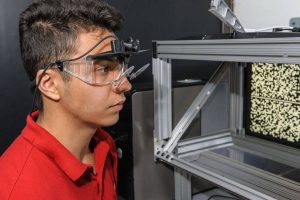According to the American Optometric Association, over 7% of children have convergence excess, which can undermine a child’s ability to learn.
Extraocular muscles are a group of six muscles that surround the eyes. These muscles control how the eyes move in unison in all directions.
The eye muscles make it possible to keep the eyes in perfect synchrony at all distances and ranges of vision throughout the day.
To do close activities like reading, we require our eyes to converge, or glance inwards towards the nose. Double vision and eye strain might result from the eyes’ inability to converge.
What is convergence excess?
Convergence excess is an eye condition where the eye muscles are imbalanced, causing them to not operate together properly— instead, one eye aims too close or in front of the other eye.
This means that the eye muscle coordination system must work harder to maintain alignment. Extraocular muscles can become so overworked that they can no longer support single, binocular vision.
Convergence excess results in diplopia (double vision), fatigue, headaches or migraines.
In people with convergence excess, the brain tries to suppress double vision by ‘turning off’ the vision from one eye.
Untreated convergence excess can result in a lazy eye or an eye turn known as esotropia.
What is esotropia?
Esotropia, a form of convergence excess, is a form of eye turn, where one eye turns too far inward compared to the other eye.
Copying from the chalkboard can be difficult for children with convergence excess. Furthermore, when children move a book closer or farther away to improve their vision, they are actually attempting to ease their convergence excess difficulties.
When these children get close enough to the page, they may utilize only their stronger eye to avoid the confusion and strain of having to use both eyes at the same time.
This excess of convergence is frequently linked to accommodative dysfunction. The eyes are directed closer in than desired in an attempt to compensate for lower focusing strength, creating eye fatigue.
If you’ve noticed your child moving closer to a page when reading, contact an eye doctor near you to evaluate their vision.
SEE RELATED: Understanding Convergence Insufficiency
Signs of convergence excess
Convergence excess is characterized by symptoms experienced while conducting close work on a computer or reading. Blurred vision at a distance is also a possibility. Convergence excess causes any combination of the following symptoms, which generally get worse as the day progresses:
- Blurred vision
- Difficulty concentrating
- Difficulty with reading comprehension
- Double vision
- Eye strain
- Feeling tired while reading
- Headaches
- Slow reading
- Words moving on the page
Vision therapy for convergence excess
Vision therapy (VT) is a successful treatment for convergence excess.
For a greater long-term reduction of convergence excess in children, vision therapy activities have been proven to be successful.
Low plus lenses
Specific eyeglasses may be useful in lowering the amount of muscle power required to read without causing symptoms. The purpose of this type of therapy is to allow the eyes to aim naturally and without exerting too much effort.
Low plus eyeglasses are a clinically proven treatment for convergence excess
Adults benefit greatly from a mix of eyeglass lenses, prisms, and some VT.
Lenses that help with focusing can make a significant impact in cases where the tendency to over-converge the eyes is greater at close range than at a distance, since when the eye focuses, it also prompts more convergence in the brain.
Convergence decreases as the focusing effort is lowered using lenses. When there is an uncorrected refractive error, such as farsightedness (hyperopia), this is even more critical.
A significant difference in vision between the two eyes, where one is more farsighted than the other, is another factor that contributes to esophoria. Amblyopia can be caused by high astigmatism in one eye, which adds to imbalanced ocular muscles.
Prism lenses
Prisms are used in vision therapy to strengthen the eye muscles. When a prism is placed in front of one eye, it must move in order to maintain focus on a target.
When prisms are used in eyeglass lenses, they allow the eyes to be in their most natural position, resulting in continuous, single vision.
LEARN MORE: Vision Therapy for Children
Schedule an appointment with an eye doctor near you to find out if vision therapy can help treat your convergence excess.









